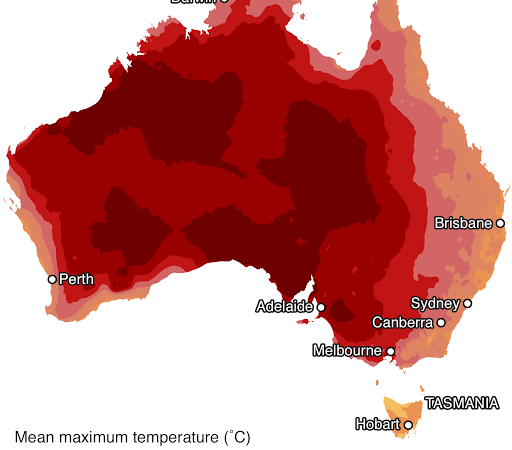
In this article, I will provide you with all the essential information you need to understand and navigate the diverse climate of Australia.
From scorching summers to mild winters, Australia’s temperature patterns can vary significantly across its vast expanse. Whether you’re planning a trip, conducting research, or simply curious about the climate Down Under, join us as we delve into the factors influencing Australia’s temperature, its regional variations, and the impact of climate change. Get ready to discover all you need to know about Australia’s temperature.
All You Need To Know About: Australia Temperature
Australia experiences a wide range of temperatures due to its large size and diverse climate. The continent is known for its generally warm to hot weather, with regions experiencing varying degrees of heat throughout the year.
In general, Australia has a predominantly arid or semi-arid climate, characterized by hot summers and mild winters. However, there are variations across different regions. The northern parts of Australia, such as the tropical north, experience a tropical climate with high temperatures and high humidity throughout the year. In contrast, the southern parts of the country, including Tasmania, have a more temperate climate with cooler temperatures.
During the summer months (December to February), temperatures in many parts of Australia can exceed 30°C (86°F) and even reach 40°C (104°F) or higher in some inland areas. Heatwaves are not uncommon during this period, particularly in central and northern Australia. It’s important to note that temperatures can be more extreme in the outback and desert regions.
Winter in Australia (June to August) is generally milder, with temperatures ranging from 10°C (50°F) to 20°C (68°F) in most areas. However, areas at higher elevations or in the southern parts of the country may experience colder temperatures, including snowfall in some mountainous regions.
It’s important to remember that Australia’s climate can be highly variable, and temperature patterns can differ significantly from year to year. It’s always advisable to check the local weather forecast for accurate and up-to-date information when planning a trip or any activities in Australia.
Temperature in Sydney, Australia
Sydney, Australia experiences mild winters and warm summers. In summer (December to February), temperatures typically range from 20°C to 30°C (68°F to 86°F), while in winter (June to August), temperatures range from 8°C to 17°C (46°F to 63°F).
So you need to use a reliable weather source for the most accurate and up-to-date temperature information for Sydney or any specific location in Australia.
Australia Temperature by Month
Here is a general overview of average temperatures in Australia by month:
January
Summer with high temperatures ranging from 25°C to 35°C (77°F to 95°F) in many parts of the country.
February
Similar to January, with warm to hot temperatures persisting.
March
Transitioning from summer to autumn, temperatures begin to cool down slightly, ranging from 20°C to 30°C (68°F to 86°F).
April
Autumn season with temperatures continuing to decrease, ranging from 15°C to 25°C (59°F to 77°F).
May
Mild temperatures ranging from 10°C to 20°C (50°F to 68°F) as autumn progresses.
June
Winter season with temperatures typically ranging from 5°C to 15°C (41°F to 59°F) in many regions.
July
Similar to June, with cool temperatures ranging from 5°C to 15°C (41°F to 59°F).
August
Continuing winter, temperatures remain cool with ranges of 5°C to 15°C (41°F to 59°F).
September
Transitioning from winter to spring, temperatures start to rise, ranging from 10°C to 20°C (50°F to 68°F).
October
Spring season with temperatures increasing further, ranging from 15°C to 25°C (59°F to 77°F).
November
Warmer temperatures continue to rise, ranging from 20°C to 30°C (68°F to 86°F).
December
Summer begins, with high temperatures ranging from 25°C to 35°C (77°F to 95°F) in many parts of the country.
It is very important to know that these temperature ranges are general guidelines, and actual temperatures can vary across different regions of Australia. It’s always best to check a reliable weather source for specific and up-to-date temperature information for a particular location.
What is the Temperature in Australia
Currently, the temperature in Australia can vary greatly depending on the region and time of year. Before you can know the exact temperature in Australia you need to make use of a reliable weather website or app for the most up-to-date information on the temperature in specific locations within Australia.
In Conclusion
Now you know the diverse and captivating world of Australia’s temperature. From the arid deserts of the Outback to the tropical rainforests of the north, Australia’s climate offers a remarkable range of conditions. We have discussed the key factors that influence temperature patterns, such as latitude, ocean currents, and elevation. Additionally, we have examined the regional variations across the country, highlighting the distinct climates of different states and territories.
Likewise, you know the pressing issue of climate change and its potential impact on Australia’s temperature in the future. By understanding Australia’s temperature, we gain valuable insights into its unique ecosystems, agricultural practices, and even tourism opportunities. Whether you’re a visitor, researcher, or resident, we hope this guide has provided you with a solid foundation of knowledge to appreciate and navigate the remarkable temperature variations in Australia.
